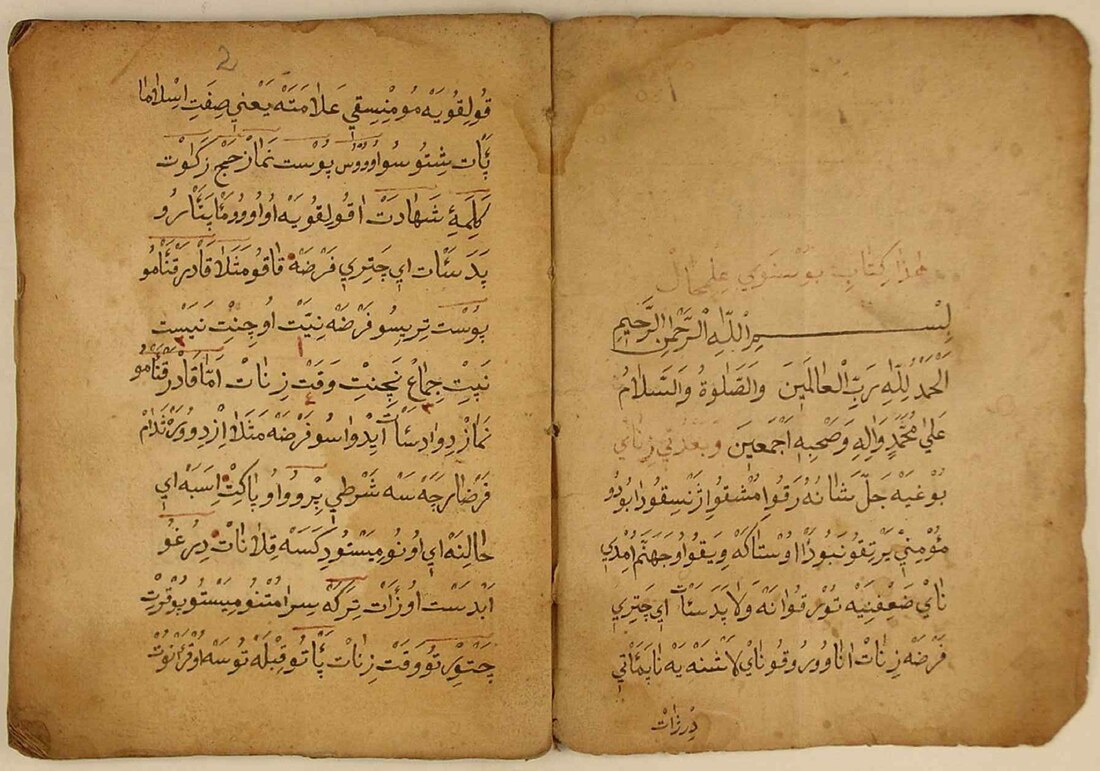Top Qs
Timeline
Chat
Perspective
Arebica
Serbo-Croatian variant of the Arabic script From Wikipedia, the free encyclopedia
Remove ads
Arebica (عربٖىڄا ,آرەبـٖٮڄآ[citation needed]; Serbo-Croatian Cyrillic: Аребица) is a variant of the Perso-Arabic script used to write the Serbo-Croatian language, namely its Bosnian standard variety.[1][2][3] It was used mainly between the 16th and 20th centuries and is frequently categorized as part of Aljamiado literature. During Austro-Hungarian rule, there were unsuccessful efforts by Bosnian Muslims to grant Arebica equal status alongside Latin and Cyrillic alphabets.[4]

Apart from literature, Arebica was used in religious schools and administration, though in much less use than other scripts. It originated in the 16th century in Ottoman Bosnia and was significantly reformed in the 20th century by the Bosnian linguist Mehmed Džemaludin Čaušević.[5]
Remove ads
Origin
Arebica was based on the Perso-Arabic script of the Ottoman Empire, with added letters for /t͡s/, /ʎ/ and /ɲ/, which are not found in Arabic, Persian or Turkish. Full letters were eventually introduced for all vowels (as with Kurdish Arabic script), making Arebica a true alphabet, unlike its Perso-Arabic base.[citation needed]
Arebica was used by the Bosnian Muslims in Central Bosnia during the Ottoman rule and continued usage during the Austro-Hungarian rule in Bosnia and Herzegovina.[6] During that period, they requested that Arebica be given equal status with the Latin and Cyrillic scripts, but the request wasn't granted.[4] The usage of the script, however, continued sporadically even after.[6]
The final version of Arebica was devised by Mehmed Džemaludin Čaušević at the beginning of the 20th century. His version is called Reformirana arebica, Matufovica, Matufovača or Mektebica.
Remove ads
Contemporary use
The first literary work to be published in Arebica since 1941 was the comic book "Hadži Šefko i hadži Mefko" in 2005, by authors Amir Al-Zubi and Meliha Čičak-Al-Zubi. The authors made slight modifications to Arebica. The first book in Arebica with an ISBN was "Epohe fonetske misli kod Arapa i arebica" ("The Age of Phonetic Thought of Arabs and Arebica")[7] in April 2013 in Belgrade by Aldin Mustafić, MSc. This book represents the completion of the standardization of Mehmed Džemaludin Čaušević's version, and is also a textbook for higher education.
Remove ads
Alphabet
Summarize
Perspective
The final version of Arebica alphabet was devised at the end of the 19th century by Mehmed Džemaludin Čaušević. The alphabet listed here is a new version made by Aldin Mustafić.
Notes
Ligatures
Like the standard Arabic alphabet, when ا connects to either ل or ڵ a special ligature is used instead.
Prior to standardization, the most widespread Arebica conventions were based on Ottoman Turkish conventions, and similar to contemporary aljamiado conventions adopted for Albanian and Greek. Vowels are often written using matres lectionis, with the exception of /e/, which is only represented word-finally, as ⟨ە⟩. /o/ and /u/ are not distinguished. /ɲ/, /ʎ/ and /ts/ were not distinguished from /n/, /l/ and /tʃ/, respectively spelt as ⟨ل⟩, ⟨ن⟩ and ⟨چ⟩. Palatal affricates /tɕ/ and /dʑ/ are both typically spelt as ⟨ك⟩, due to the Persian letter ⟨گ⟩ not having been widely adopted yet, while velar stops /k/ and /g/ are represented with ⟨ق⟩ and ⟨غ⟩.[8]
Text examples
Article 1, Universal Declaration of Human Rights
| Serbo-Croatian ( Arebica) [9]: | سوا ڵۆدسقا باٖىڃا راݗايۆ سە سلۉبۉدنا اٖى يەدناقا ۆ دۉستۉيانستوۆ اٖى پراواٖىما. ۉنا سۆ ۉبدارەنا رازۆمۉم اٖى سواٖىيەشڃۆ اٖى ترەبا دا يەدنۉ پرەما درۆغۉمە پۉستۆپايۆ ۆ دۆحۆ براتستوا. |
| Serbo-Croatian (Latin): | Sva ljudska bića rađaju se slobodna i jednaka u dostojanstvu i pravima. Ona su obdarena razumom i sviješću i treba da jedno prema drugome postupaju u duhu bratstva. |
| Serbo-Croatian (Cyrillic): | Сва људска бића рађају се слободна и једнака у достојанству и правима. Она су обдарена разумом и свијешћу и треба да једно према другоме поступају у духу братства. |
| English: | All human beings are born free and equal in dignity and rights. They are endowed with reason and conscience and should act towards one another in a spirit of brotherhood. |
Tehran
| Serbo-Croatian (Arebica): | تەهەران يە غلاونی ای نايوەڃی غراد ایرانا، سيەدیشتە تەهەرانسقە پۉقرايینە ای يەدان ۉد نايوەڃیح غرادۉوا سویيەتا. | |
| Serbo-Croatian (Latin): | Teheran je glavni i najveći grad Irana, sjedište Teheranske pokrajine i jedan od najvećih gradova svijeta. | |
| Serbo-Croatian (Cyrillic): | Техеран је главни и највећи град Ирана, сједиште Техеранске покрајине и један од највећих градова свијета. | |
| English: | Tehran is the capital and largest city of Iran, capital of Tehran Province and one of the largest cities in the world. |
Remove ads
See also
- Aljamiado
- Belarusian Arabic alphabet, another script used by Slavic-speaking Muslims
- Chirvat-türkisi
- Gaj's Latin alphabet
- Muhamed Hevaji Uskufi Bosnevi
- Sevdah
Footnotes
Bibliography
External links
Wikiwand - on
Seamless Wikipedia browsing. On steroids.
Remove ads
